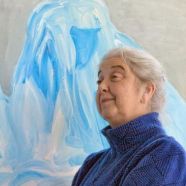Nerys Levy
I grew up in North Wales in a Welsh-speaking household that included a poet/artist grandfather who was from Snowdonia, North Wales’s mountainous region. It was the place where artists such as J.M.W. Turner and some of the British artist founders of the Hudson Valley School accessed ethereal landscapes during Europe’s turbulent nineteenth-century politics, when traveling to paint on the continent was often restricted. Having a grandfather artist-in-residence during my formative years clearly shaped my interests and my way of looking at my surroundings. Added to his presence was my exposure, from the age of three, to the local Welsh language school where the arts—drawing, clay, music—dominated every afternoon’s activities. Our harpist teacher, Osian Ellis, saved from death in World War II because of his outstanding musical talents, schooled us in penillion (Welsh contrapuntal) singing until he left for London and a job in the Royal Academy and a side job as the Queen’s harpist. With this background I felt destined to become an artist.
Alas, my father and high school headmaster had other ideas and routed me into more academic pursuits and teaching. After two years teaching as a British Peace Corps volunteer in Jamaica and thereafter schooling South Asian immigrants in London, Social Administration studies at the London School of Economics were called for to digest my experiences. My professors there, many of whom were the architects of the British National Health Service, directed me to a career in British race relations, which took me to India and South Africa at the height of apartheid. This work became a segue to the School of Oriental and African Studies at London University where I gained a PhD in Modern South Asian History, which included a thesis on Welsh missionaries in India during the Raj. After paying my dues to my family’s plans for my academic career and a move in 1979 to the United States upon my marriage, I began serious art studies at the University of California, San Diego, where my husband was a professor of anthropology.
Having been prevented from pursuing a career in the arts in my earlier life, I was now determined to become the artist I had always wanted to be. But now I also had administrative and teaching skills, which prepared me for a future as a community arts activist. At the University of California San Diego (UCSD) I encountered artists involved in the avant-garde. This was all new and somewhat alien to me, but I embraced art classes and groups steeped in abstraction and artistic rebellion—UCSD was, after all, the center of the “happening” movement in the 1970s and 1980s. It was with some relief that after five years of total immersion in this atmosphere my husband’s sabbatical at a Stanford think tank brought me into contact with the Palo Alto Art League and a wonderful Belgian plein air art teacher there who reconnected me with my European roots and landscape painting.








Nerys,
Wow! you have had quite the journey. I feel privileged to be in your class. I will try to be nonjudgmental about my work.
Thanks for your guidance.
Anne O’Connor